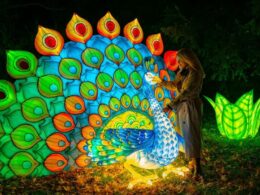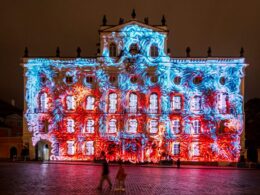Cuprins Arată
The Czech Museum of Cubism, in the Czech capital is a devoted venue to one of the most unique and original art movements: Czech Cubism. This structure, which was created by Josef Gočár, exemplifies the Cubist style through its elaborate facade and sharp angles.
The Czech Museum of Cubism not only displays Czech Cubism’s architectural and artistic masterpieces but also provides an in-depth explanation of its cultural and historical relevance. The museum, housed in the renowned House of the Black Madonna, takes visitors on a fascinating trip through how Czech artists and architects interpreted and developed Cubist ideas.
The Museum of Cubism’s permanent collection spans the years 1910–1919. The display features a variety of furniture, including couches, dressing tables, coat racks, desks, seats, tables, and sideboards. It also includes tableware, paintings, and glasses for both tea and dinner. The House of the Black Madonna’s design shop, Modernista, sells these replicas if you’re interested.
Introduction to Czech Cubism and its influence
If you’re wondering about Czech Cubism, Czech Cubism is a separate subset of the Cubist movement that originated in the early twentieth century. Unlike its French equivalent, which concentrated mostly on painting, Czech Cubism architecture, the design of furniture, and applied arts. It is distinguished by sharp geometric shapes and the usage of crystal-like structures to provide a sense of motion and dynamic tensions.
Since its inception, Czech Cubism has expanded the possibilities for the use of space and form in creative endeavors on a global scale.
National impact
Cubism had a profound impact on Czech art and architecture, helping to establish the style as an integral part of Czech national identity. The unique national style that emerged throughout the movement and is still admired today was influenced by its emphasis on geometric abstraction and dynamic forms.
International influence
Beyond its home country, Czech Cubism has been an influential style in contemporary design and architecture all across the globe. Thanks to its fresh perspective on space and shape, it has sparked fresh ideas among architects and designers for making interactive and practical spaces.
Museum opening hours : The House of the Black Madonna
The opening hours of the Czech Museum of Cubism sunt următoarele:
- Monday: Closed
- Tuesday: 10:00 AM – 6:00 PM
- Wednesday: 10:00 AM – 6:00 PM
- Thursday: 10:00 AM – 6:00 PM
- Friday: 10:00 AM – 6:00 PM
- Saturday: 10:00 AM – 6:00 PM
- Sunday: 10:00 AM – 6:00 PM
Cubism and Czech architecture: A historical overview
What is the relationship between Cubism and Czech architecture? Cubism and Czech architecture have a distinct and intertwined association that is especially relevant in the history of modernist movements.
It was in the 1910s that Prague became the epicenter of Czech Cubism, a style that combined the radical principles of Cubism with the rich cultural heritage and architectural history of the Czech Republic. Angular patterns and geometric shapes were prominent in the Cubist style that the Czech architects adopted.
Czech architects developed a unique style that has stood the test of time by applying Cubist ideas to architecture. Both the conserved structures and the movement’s continuing impact on modern architecture attest to Czech Cubism’s enduring significance in the cultural and architectural heritage of the country.
Visiting the Cubism Museum in Prague: What to expect
An unforgettable journey into the realm of Czech Cubism is waiting for you at the Cubism Museum in Prague. In this extraordinary museum, you will find the following exhibits.
Permanent exhibition
Modern Cubist buildings & decor: Look at the scale models, photos, and architectural plans that show how the Cubists uniquely used their concepts for city planning and building construction. The exhibitions highlight how Cubism altered the scenery in Prague and the rest of the Czech Republic.
Furniture by Cubists: Impressive pieces of furniture created by prominent Czech Cubists are on display in the museum. Chairs, tables, and lamps are just a few examples of ordinary objects that showcase the geometric forms and abstract aesthetics that are characteristic of this movement.
Cubist art: Take a look at the artwork of well-known Czech Cubists including Bohumil Kubišta, Josef Čapek, and Emil Filla. Pieces like these demonstrate how the movement deconstructed forms and delved into geometric abstraction.
Temporary exhibitions
Curated temporary exhibitions explore many facets of Cubism and its impact on modern art and design at the muzeu. Czech Cubism is placed within the greater European art landscape in these displays, which frequently feature works by international artists.
Opinion and rating of the Cubism Museum : The House of the Black Madonna
Luând în considerare toate aspectele, Muzeul ceh al cubismului colecția remarcabilă, valoarea educațională și importanța cadrului său arhitectural îi aduc mari laude. Muzeul prezintă frumos impactul cubismului asupra Cultura cehă prin vasta sa colecție de opere de artă, mobilier și proiecte arhitecturale, prin urmare, este considerat frecvent de către vizitatori drept o destinație culturală de top în Praga.
Google rating: ★★★★☆ (4.4/5)
Notable Czech Cubist artists and architects
The Czech Cubist movement, which had its origins in the avant-garde, produced seminal works across several artistic disciplines by challenging and ultimately redefining conventional ideas and practices. The Czech Republic was home to several influential Cubists, so let’s take a look at a few of their most famous artists and architects.
- Pavel Janák (1882-1956)
- Josef Gočár (1880-1945)
- Bohumil Kubišta (1884-1918)
- Otto Gutfreund (1889-1927)
- Emil Filla (1882-1953)
- Vincenc Beneš (1883-1979)
- Vlastislav Hofman (1884-1964)





